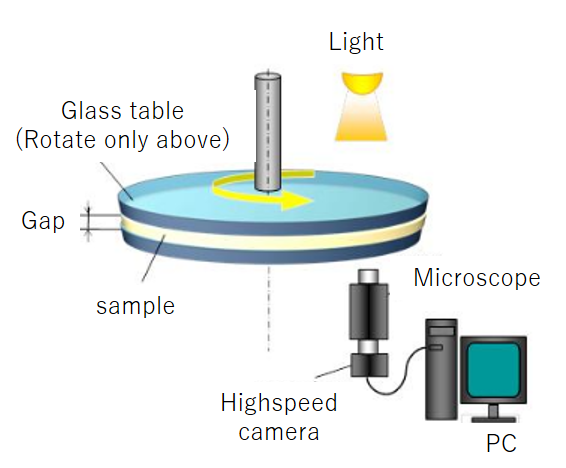The Takahashi laboratory is divided into two groups of wind group and Leo group according to the nature of the fluid. Each group is divided according to the research subject.
- Wind Team : Research on fluid related vibration for Newtonian fluid such as water and air.
- Rheology Team : Research on rheology (complex fluid) for non-Newtonian fluid such as surfactant, liquid crystal, polymer solution.
Rheology Team Cosmetics Group
Elucidation of flow behavior of complex fluid with weak structure
Food such as mayonnaise or the ketchup, cosmetics such as the emulsion, blood, ink, etc. we have various kind of liquids around us.These are made by adding water (or oil) to another substance, and because of having a complicated composition, it is called "complex fluid".
We pay attention to emulsion and gel used in food and cosmetics in this complicated fluid and study it.
We focus on emulsions and gels which are frequently used in foods and cosmetics among these complex fluids.
Though these samples retain their shape during standing, they have the property of flowing when weak force is applied and maintaining the shape again when the force is removed. This characteristic is related to the flow behavior weak internal structure" collapse "and" restructuring ".
This weak force flow behavior is weak enough to be neglected in pipe transportation in factory production lines.
However, in products related to sensitive human senses such as food and cosmetics, a slight difference in flow behavior affects the evaluation.
Therefore, if it is possible to elucidate the mechanical properties such as the flow characteristics and the strength of the internal structure, it will lead to improvement of the use feeling and comfort of the product, the quality stability by restructuring, contributing to more functional product development I can do it.

As a method for that, "Leo optic measurement" is introduced. This is a method of simultaneously measuring the flow characteristics such as viscosity and elasticity of fluid by rheometer and measuring optical characteristics such as refractive index change and light scattering.
The refractive index and scattering properties are determined by the molecular structure, particle shape, arrangement, etc. of the fluid and substances dispersed in the fluid
We investigate change of the internal structure of fluid accompanying flow by comparing mechanical physical property data such as viscoelasticity and optical data such as birefringence and dichroism.

Elucidation of flow behavior of skin care cream
In our laboratory, as a method to elucidate the flow behavior of complex fluids, measurement of fluid flow characteristics by rheometer, measurement of optical properties such as refractive index change and light scattering, visualization by microscope & high speed camera are performed I will.We're doing research focusing on visualization among them, and aims to observe and elucidate the fluid flow behavior by a microscope and high-speed camera.
The figure below shows the outline of the experimental apparatus.
Visualize the state of flow of gel and emulsion with rheometer by microscope & high-speed camera.
Changes in mechanical properties such as viscosity and elasticity of the fluid obtained by the rheometer may be due to microscopic changes at the molecular level or macrostructural changes such as textures and clusters.
In our laboratory, changes in the microstructural structure are observed by optical anisotropy such as birefringence.
However, in regard to macroscopic structural changes, the visualized image captured at this high speed microscope takes a big role in elucidating the phenomenon .
Attach a flow path made of optical glass (parallel disk type flow path in the figure below) to the rheometer and observe directly macroscopic structure change of fluid synchronize with flow characteristic measurement such as viscosity and elasticity by microscope & high speed camera. Currently we will clarify the yielding behavior of gels and emulsions.

